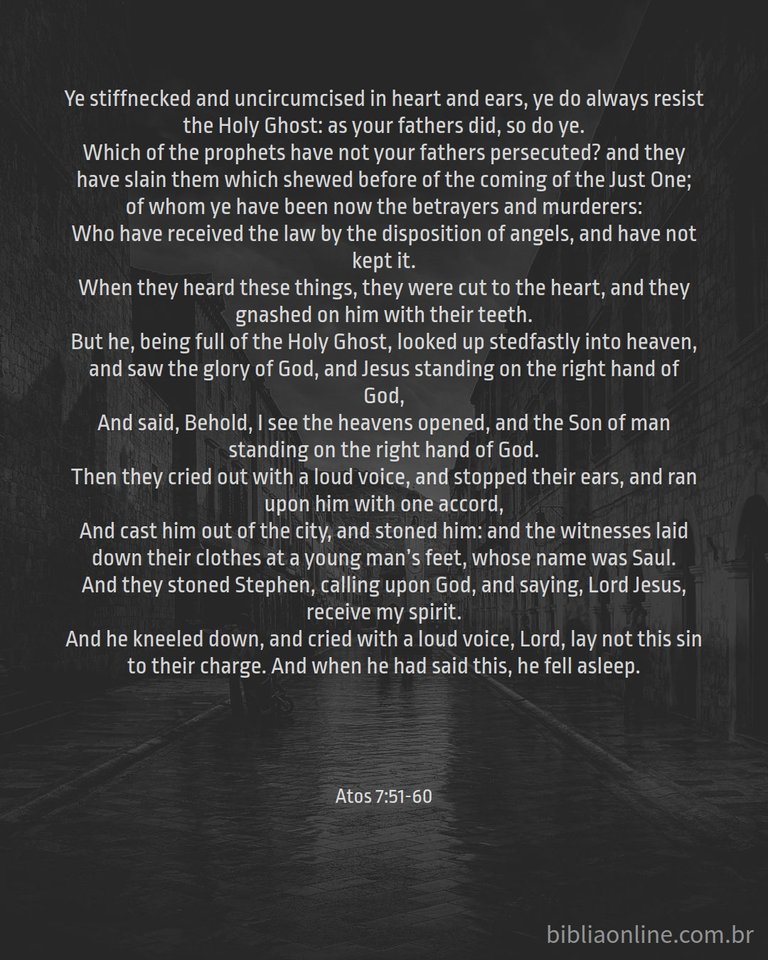
English Version
Today's reading of Acts of the Apostles (7,51-8,1) brings us the account of the sad and unfortunate execution of Saint Stephen, the first Christian martyr, at the hands of the people and the doctors of the law.
Physical uncircumcision, a mark of the old covenant, was a physical mark of the covenant between God's people and God. As a physical proof of a man's devotion to God and submission to the Creator's laws, it was the physical mark that united all the servants of the Logos in the Old Testament. However, just as God's people were no longer united by blood ties (Mark 3:33-35), circumcision was no longer literal, and it stopped being a physical mark to be a spiritual mark, where your heart becomes open to the words of the Lord and to recognize the greatness of the Creator and creation. Given this contextualization, and, added to the general context of the text, we can understand that the uncircumcised in heart are those who voluntarily deny hearing the word of God, as well as those who actively rebel against God, against the prophets, and, above all, everything, against Christ.
After this, those who heard him were overcome with anger, not anger because his words were lies, but anger because they were not able to soften their hearts and receive those words in a benevolent way. At this, Stephen, filled with the Holy Spirit, said that he saw the heavens open, with the son of man (Christ) standing at the right hand of God. Generally, Christ is represented sitting next to the Father, but, in this situation, the Father was standing, as he already knew what would happen, and was about to receive his beloved son with open arms.
At this, the crowd becomes enraged, and they execute him by stoning him (a common penalty for blasphemy crimes at the time). However, even in this situation, Stephen still blessed his evildoers, asking for mercy from them, showing the purity in the heart of one who was part of the mystical body of the Church (I Corinthians 12:12-14, Colossians 1:18), and who, Even suffering the worst tortures, any of those who experienced what was said were unable to deny it.
Stephen, after the stoning, asked forgiveness for the mistakes of those who condemned him (John 20:22-23), and expired, leaving the militant church to meet with those who were part of the triumphant church. Interestingly, Saul of Tarsus, who would later be known as the apostle Paul, was one of those who supported the brutal execution.
This is my reading of the excerpt. Hope this helps.

Versão em Português
A leitura de Atos dos Apóstolos (7,51-8,1) de hoje traz a nós o relato da triste e infortúnia execução de Santo Estevão, o primeiro mártir cristão, pelas mãos do povo e dos doutores da lei.
A incircuncisão física, marca da antiga aliança, era uma marca física da aliança entre o povo de Deus e o mesmo. Tal como uma prova física da devoção de um homem a Deus e da submissão às leis do Criador, era a marca física que unia a todos os servos do Logos no Antigo Testamento. Porém, assim como o povo de Deus não era mais unido por laços de sangue (Marcos 3:33-35), a circuncisão não era mais literal, e deixou de ser uma marca física para ser uma marca espiritual, onde seu coração se torna aberto para as palavras do Senhor e para reconhecer a grandeza do Criador e da criação. Dada esta contextualização, e, somado ao contexto geral do texto, podemos entender que os incircuncisos de coração são aqueles que voluntariamente negam ouvir a palavra de Deus, assim como a aqueles que se rebelam ativamente contra Deus, contra os profetas, e, acima de tudo, contra Cristo.
Após isto, os que o ouviam foram tomados de raiva, não raiva pelas palavras dele serem mentiras, mas sim raiva por não serem capazes de amolecer seus corações e receber aquelas palavras de forma benevolente. Nisto, Estevão, cheio do Espírito Santo, disse que via os céus abertos, com o filho do homem (Cristo) de pé, a direita de Deus. Geralmente, Cristo é representado sentado ao lado do Pai, mas, nesta situação, este estava de pé, pois já sabia o que haveria de ocorrer, e estava prestes a receber seu filho amado de braços abertos.
Nisto, a multidão se enfurece, e o executam, apedrejando-o (pena comum para crimes de blasfêmia na época). Porém, mesmo nessa situação, Estevão ainda abençoou seus malfeitores, pedindo por piedade a estes, mostrando a pureza no coração daquele que fazia parte do corpo místico da Igreja (I Coríntios 12:12-14, Colossenses 1:18), e que, mesmo sofrendo as piores torturas, qualquer um daqueles que vivenciaram o que foi dito era incapaz de negar.
Estevão, após o apedrejamento, pediu perdão pelos erros daqueles que o condenaram (João 20:22-23), e expirou, deixando a igreja militante para se encontrar junto a aqueles que faziam parte da igreja triunfante. Curiosamente, Saulo de Tarso, que mais tarde seria conhecido como o apóstolo Paulo, foi um dos que apoiou a execução brutal.
Esta é minha leitura sobre o trecho. Espero ter ajudado.
Obrigado por promover a Língua Portuguesa em suas postagens.
Vamos seguir fortalecendo a comunidade lusófona dentro da Hive.